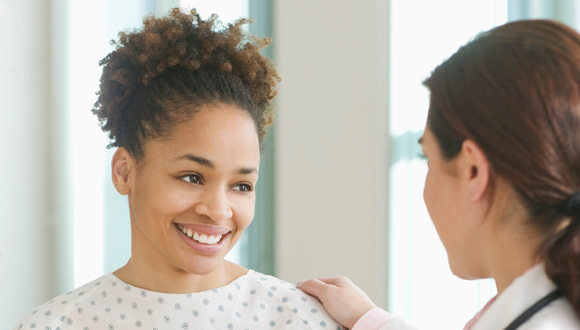Uterine fibroids are noncancerous growths that develop on the walls of the uterus. They typically occur during a woman's premenopausal years. And, according to the National Institutes of Health, one study found that 70% of white women and 80% of African-American women develop fibroids by the time they reach age 50.
Let's discuss what you should know about uterine fibroids and how they're treated.
Symptoms of uterine fibroids
According to Dr. Lucho Rossman, interventional radiologist at Houston Methodist, most fibroids cause no significant symptoms. However, the size of a fibroid as well as its location may cause excessive pain and heavy bleeding in some women.
Common symptoms of fibroids include:
- Back or leg pain
- Bleeding between periods
- Constipation
- Difficulty becoming pregnant
- Difficulty emptying your bladder
- Frequent urination
- Heavy menstrual bleeding
- Menstrual periods lasting more than a week
- Pelvic pressure or pain
- Pain during intercourse
- Swollen or bloated abdomen
In some cases, fibroids can result in premature labor and miscarriage.
Once a fibroid is detected, often during a routine pelvic exam, you may need additional tests, which include:
Pelvic MRI: Provides images of your uterus, ovaries and other pelvic organs.
Ultrasound: Uses high-frequency sound waves to produce images of the structure of your uterus and any fibroids. A transvaginal ultrasound, where the ultrasound wand is inserted into the vagina, can provide more precise images.
Risk factors for uterine fibroids
Doctors don't know exactly what causes fibroid tumors, but hormones and genetics can make you more likely to develop them. According to Dr. Stephanie Bruce, gynecologist at Houston Methodist, risk factors for developing fibroids include:
- Being African-American
- Early onset menstruation
- Having a family history of fibroids
- High blood pressure
- Obesity
How fibroids are treated
If your symptoms are mild, your doctor may suggest a wait-and-see approach, as fibroids grow slowly — or not at all — and tend to shrink after menopause.
The first course of treatment to ease mild to moderate symptoms is medication. Medication options include nonsteroidal anti-inflammatory drugs (NSAIDs), antifibrinolytics (a medication prescribed for heavy menstrual bleeding) and hormonal therapies.
Other treatment options include:
Uterine fibroid embolization (UFE). UFE is a minimally invasive procedure performed by an interventional radiologist for women who can't tolerate medications. The interventional radiologist injects small particles into the arteries supplying the uterus. These particles cut off blood flow to fibroids and cause them to shrink and die. Within two to four months, there is usually a 40% to 60% reduction in fibroid size.
"This procedure is an alternative to open surgery or laparoscopic surgery for fibroids," Dr. Rossman says. "UFE is performed while the patient is sedated and feeling no pain. It does not require general anesthesia."
Minimally invasive myomectomy. Minimally invasive myomectomy involves various procedures to remove fibroids while leaving the uterus in place. During a myomectomy, a surgeon inserts thin instruments through small incisions in your abdomen. With robotic myomectomy, a tiny camera attached to one of the instruments gives your surgeon a 3D view of your uterus, offering greater precision and flexibility than other techniques. Hysteroscopic myomectomy involves removal of the fibroids through the cervix, without an incision.
Hysterectomy. A hysterectomy is a major surgery in which a surgeon removes the uterus. While a hysterectomy is the only proven permanent solution for fibroids, it ends your ability to bear children.
"When I started practicing 20 years ago, hysterectomy was a common procedure for fibroids," Dr. Bruce says. "With advances in technology, many of my patients are happy with minimally invasive treatments."
There are many options available to ease the pain and symptoms of uterine fibroids. They aren't just something you have to live with. Talk to your doctor about your options so you can decide on the course of action that's right for you.


